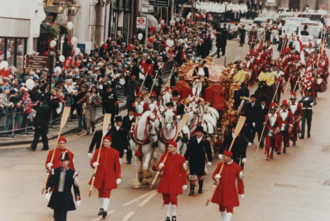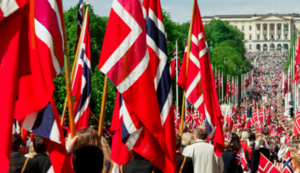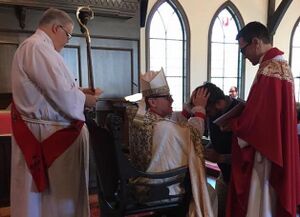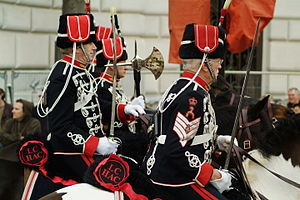King's Day
| King’s Day | |
|---|---|
 The Royal Procession in Lendert-with-Cadell. | |
| Observed by | Great Nortend |
| Type | Full holiday |
| Significance | Loyalist, patriotic and religious festival |
| Celebrations | Processions and parades, fairs and pageants |
| Date | Whitsun, 7th Sunday after Easter |
| Frequency | Annual |
The King’s Day is a red letter full holiday in Great Nortend jointly celebrated annually on the Christian festival of Whitsun or Pentecost on the fiftieth day after Easter. As such, it is a moveable holiday, although it always falls on a Sunday. Under the name of „King’s Day”, the holiday celebrates the kingship of the Sovereign of Great Nortend, the monarchy, dynasty and the kingdom. During the reign of a queen regnant, the holiday is called the Queen’s Day.
History
Pentecost was traditionally associated by the Jews with the birth and death of King David, and the descent of the Holy Ghost upon the civil rulers in the Book of Numbers and upon King Saul in the first Book of Samuel. This association continued into Christianity with the descent of the Holy Ghost upon the Apostles and the sacrament of holy Confirmation. In mediaeval Nortend in particular, Whitsun developed into a day of recognising the right of civil authorities who have been set by God to rule over their dominions, expressly calling to mind the descent of the Holy Ghost upon the sovereign at his coronation with the singing of the hymn „Come Holy Ghost” which is sung throughout Whitsun Week.
Already in the 15th and 16th centuries, there was a growing association between confirmation in the Church and the oath of liegeance to the Crown taken by children when they came of age. After the Small Schism in 1614, this became stronger and formally promoted by the Crown and churchmen who saw membership in the national Church of Nortend essential for subjects of the Crown under the principle of cuius regio, eius religio.[1] A coronation according to the rites of the Church of Nortend were legally required of the Sovereign under the Acts of Cleaving in 1642, which also required that Nortish subjects be „confirmed” and take the oath of liegeance before the age of majority, 21.
The day was not, however, formally proclaimed as one in honour the Crown until 1817. Edmund VII had recently acceded to the throne as the head of the House of Anthord after the end of the Olnite dynasty at the death of the immensely popular Catherine I. Edmund’s ministers had arranged for lavish celebrations both in thanksgiving for the reign of Catherine and for the reign of Edmund and the restoration of the House of Anthord in 1815 and 1816.
They enriched an existing week-long period of festivities during the octave of Whitsun. Te Deums in honour of the coronation were ordered to be sung on Whitsun in church, and special prayers written for the occasion. The festivities proved highly popular, and were formalised by a proclamation in 1817 that the day of Whitsun be kept for ever with prayers and thanksgiving for the King and his Dominions.
In 1863, for the Jubilee of Edmund VII, the King’s Day was marked by long and festive processions with music and banners after end of the Whitsun mass through the streets throughout the kingdom. The King held a fete and staged a mock mediaeval tournament, held at Hameford Castle, culminating in a fireworks display in the evening. Similar festivities persisted after the jubilee year, and the King’s Day processions and parades soon became a fixed staple of celebrations, although the fetes, tournaments and pageants merged with the existing fairs, races and public entertainments held on Whit Monday, Whit Tuesday and through Whitsun Week.
In 2019, the King’s Day celebrations centred on the 500th anniversary of the first king of the House of Anthord, William II, who acceded to the throne in 1519.
Proceedings

As Whitsun, or Pentecost, commemorates the descent of the Holy Ghost upon the Apostles, it has been the most popular time in the church calendar to confer the sacrament of holy Confirmation. By tradition, Nortish children are confirmed around the age of 12 after having been taught the Pater noster, Ave Maria, Credo in Deum, Ten Commandments and Small Catechism.
Each year on Whitsun a portion of the Second Form attend church in their local deanery church to be confirmed by their local archdeacon as the deputy of the bishop of the diocese. The rest of the cohort are confirmed by the archdeacon before similar masses during Whitsun Week. Though by right a bishop is the ordinary minister of confirmation, by tradition and necessity archdeacons have mostly taken over this duty owing to the impossibility of a single bishop confirming nearly all children of age in his diocese during Whitsun Week, as their mothers, fathers and custom demand.
The rite is simple, and on Whitsun proper, takes place immediately after the Whitsun procession and afore the mass. The confirmands return with the procession into the chancel of the church, or if there is no space, in the forenave, and kneel before the archdeacon sitting on the faldstool placed at the foot of the altar steps. The versicles Adjutorium nostrum and Sit nomen Domini are said, followed by Dominus vobiscum. The archdeacon then says the ancient confirmation prayer Omnipotens sempiterne Deus which calls down the sevenfold gifts of the Holy Ghost upon the confirmands.
He then confirms each of the confirmands who, by placing his right hand on the head and using his thumb to sign the forehead with chrism oil, saying,
N., I sign thee with the Sign of the Cross and I confirm thee with the Oil of Salvation; in the name of the Father and of the Son and of the Holy Ghost. Amen.
This constitutes the essential matter of the sacrament. A godfather or godmother, depending on the child’s sex, also stands behind him while the archdeacon confirms him, as a symbol of the conclusion of his formal duties.
After the children have all been confirmed, Psalm 128, Beati omnes, is chaunted followed by the versicle Emitte spiritum and Pax vobis. Then the archdeacon says the prayer Deus qui apostolis. The oath of liegeance is then taken before the bailiff of the hundred, as the King’s representative therein, immediately after. All of the newly confirmed are administered the oath of liegeance by the archdeacon. The oath is in the form,
I A. B. swear that I shall faith and troth bear unto our Sovereign Lord the King and unto his heirs and successours against all manner of folk to live and die. So help me God.
By taking the oath, the children confirm their loyalty to the Crown and their full subjectship thereof, though secondary to their loyalty to God. The archdeacon then concludes with a blessing over the confirmed, Benedictio Dei omnipotentis. Immediately thereafter, the high mass of Whitsunday begins with the Office anthem, Spiritus Domini. At the mass, the newly confirmed will receive holy communion for the first time.
After the mass, which occurs around noon, there is usually a public procession for King’s Day. This should not be confused with the religious procession before mass, which perambulates within the church only. The procession is usually festive, with banners and flags flying and music playing with songs and anthems. Local dignitaries and peers may ride in procession, whilst military and cadet units march along with the people through the streets of the town. The procession usually then ends in the market square of the town, or some other suitable location. There is then usually a military parade and speeches. The King’s annual speech is given in Lendert-with-Cadell at Edcheap, a copy of which is sent beforehand to bailiffs around the country to be read out on the King’s behalf.
Activities
References
- ↑ Whose kingdom, whose religion
This page is written in Erbonian English, which has its own spelling conventions (colour, travelled, centre, realise, instal, sobre, shew, artefact), and some terms that are used in it may be different or absent from other varieties of English. |


